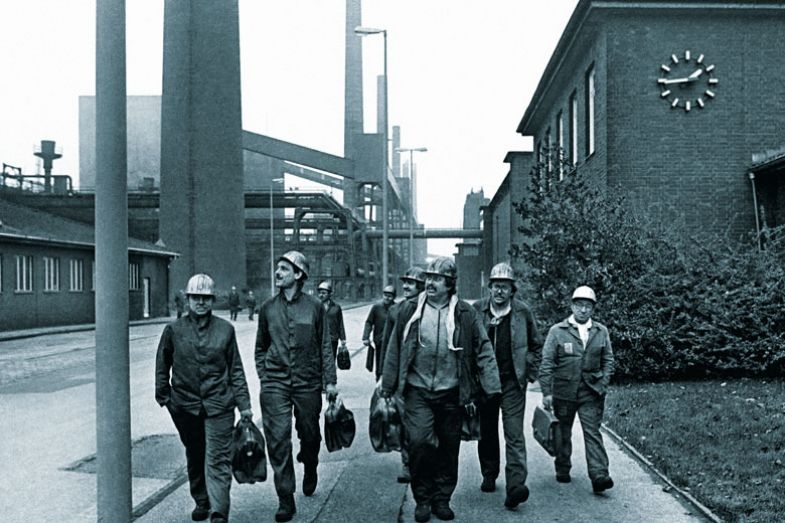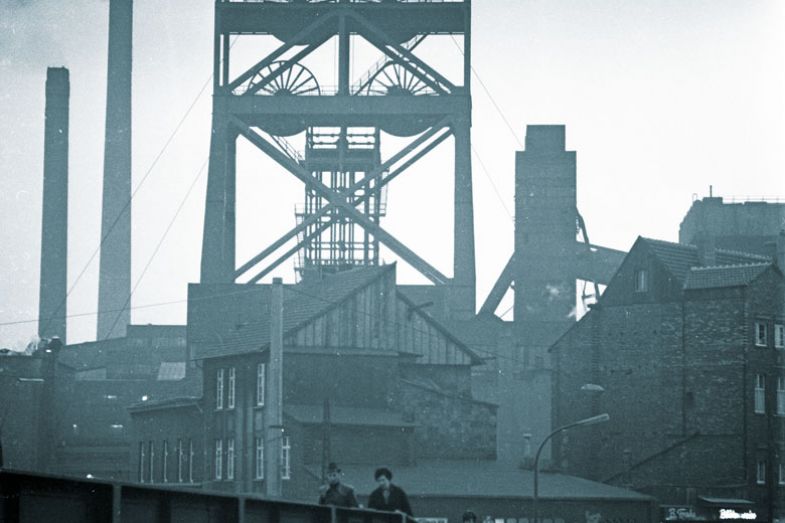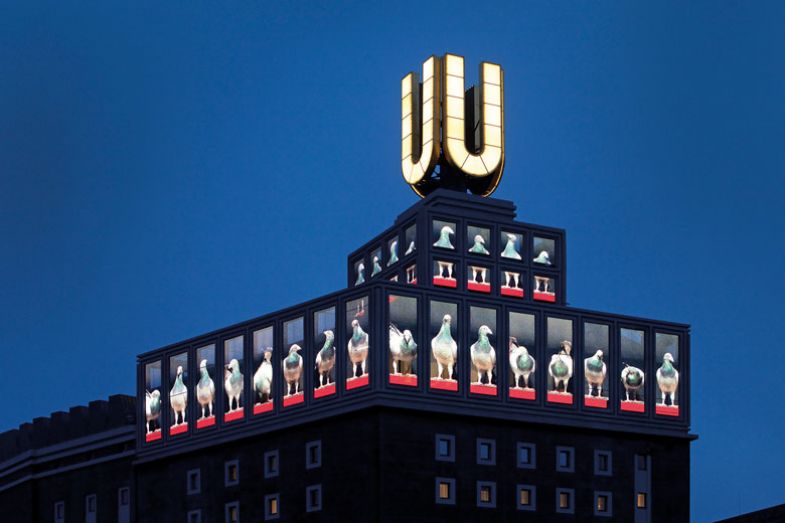Among the grey, low-rise apartment blocks of northern Essen is the Zeche Zollverein, once the largest coal mine in the world. Past its iron gates is a huge steel winding tower that used to lower miners underground until its giant wheels came to a permanent halt when the mine closed in 1986.
The “Customs Union Mine” lies in the geographical centre of the Ruhrgebiet (known in English as the Ruhr Valley or just the Ruhr), formerly Germany’s industrial powerhouse of coal and steel and still a densely populated region, consisting of more than 5 million people spread across 53 towns and cities, including the major cities of Duisburg, Essen, Bochum and Dortmund, in a 40-mile east-west stretch.
Today, the Zeche Zollverein’s tower has a commercial afterlife as a T-shirt and fridge magnet symbol of the Ruhr revival. The transformed former mine, designated a Unesco World Heritage Site in 2001, attracts 2 million visitors a year to its Ruhr Museum and Red Dot Design Museum (housed in an old boiler house redesigned by the celebrated British architect Lord Foster of Millbank), as well as to its art fair, restaurants, hotel, ice rink and swimming pool. You can wander along disused railway tracks underneath conveyor bridges, past the rusting pipes and chimneys of the silent coking plant, and through the trees and greenery that are reclaiming the huge site.
The Zeche Zollverein symbolises how globalisation and deindustrialisation wrought massive economic and social change on a region where work and life were based around coal and steel. The Ruhr is now trying to reset its grimy post-industrial image with a sunnier brand based around its cutting-edge culture, green space, leisure and quality of life (in a location much more affordable than Berlin or Munich).
And there is another key element to the new vision. In February, the state government of North Rhine-Westphalia (NRW, Germany’s most populous state, which includes the Ruhr) handed over €75 million (£64 million) to the Research Alliance Ruhr, a collaboration involving Ruhr University Bochum, TU Dortmund University and the University of Duisburg-Essen (UDE).

The money will create four new joint interdisciplinary research centres in health, sustainability, digitalisation and energy, and fund the creation of 50 new professorships, plus 500 junior and senior researcher posts. The aim, NRW’s minister-president said at the time, is to hire “brilliant minds from throughout the whole world to work here with us on the major questions of the future”.
Former industrial regions are not just a defining economic concern for Western nations: they have seismic political impact through their role in shocks such as the election of Donald Trump and the Brexit vote. In that context, the role of universities, research and innovation in helping to create a new economic future in deindustrialised areas is increasingly under the spotlight. The transformation of the Ruhr into, as it now bills itself, “one of the densest research landscapes in Europe” by combining and boosting the research power of three universities founded there in the 1960s to a world-class level could act as a model for other regions similarly left behind by the forces of globalisation.
The thinking behind the Research Alliance Ruhr goes back to Christmas Eve 2018, at a coal mine in the local city of Bottrop. There, the federal president of Germany, Frank-Walter Steinmeier, was handed the last ever lump of coal mined in the Ruhr, in a ceremony marking the culmination of a planned, phased withdrawal from mining designed to minimise unemployment.
But the NRW state government, based just outside the Ruhr in Düsseldorf, wanted to ensure that this story wasn’t just about the end of coal. Earlier in 2018, the regional government, led by the centre-right CDU, initiated a Ruhr Conference, which saw each government ministry tasked with consulting institutions and the public, eventually resulting in 73 projects “to make the region a better place”.
The Research Alliance Ruhr is one of those Ruhr Conference projects – and, of the 73, it has secured by far the largest amount of funding.
Martin Stratmann, one of the most influential figures in German science as president of the Max Planck Society, the nation’s highly respected network of basic research institutes, helped set in motion the idea that eventually became the alliance. Building on the long tradition of collaboration between the three universities (students at one university can pick courses at another, and a Max Planck Institute for Security and Privacy was founded in Bochum in 2019), Stratmann “took the chance” to approach Armin Laschet, the region’s minister-president and soon-to-be national CDU leader.
“What I wanted to push forward was the idea that the Ruhrgebiet…has overcome many of the burdens which it has had over the last years,” says Stratmann, who studied chemistry at Bochum. But its “transition” to a more modern economy “will only work if new industry will settle there; and that this new industry in most cases is based on scientific excellence.”
He highlights some key factors in the Ruhr’s favour as a science region, such as space to create new city-centre campuses on land vacated by former factories and steel plants, and the “huge density of transportation” originally built to move iron ore or steel that can now be used to “interconnect” the new campuses. “The idea I had was: ‘Why not have a look at what happens in the University of California, where you have a system of universities which also compete to some extent – for funding, for professors – but there is a common goal?’” says Stratmann. “The talk [with the minister-president] ended with my wish to come to a modern view on development of the university [system] as a nucleus of transformation of the Ruhrgebiet to the modern world.”
And given the Max Planck Society’s five sites in the Ruhr, it is “in our interest to have a highly developed, visible, attractive university system in the Ruhrgebiet to make sure our institutes flourish”, Stratmann adds.
In fact, as well as universities, the Ruhr has a striking concentration of Germany’s internationally renowned research institutes: four Leibniz Association institutes for interdisciplinary research, four Fraunhofer Institutes for application-oriented research, plus the five Max Planck Society sites. The Max Planck Institute for Coal Research in Mülheim is home to the winner of the 2021 Nobel Prize in Chemistry, Benjamin List.
Stratmann had “good communication” with the three universities on the Research Alliance Ruhr proposal that they subsequently developed with the NRW government. The four research centres eventually granted funding are titled One Health – from Molecules to Systems; Chemical Sciences and Sustainability; Trustworthy Data Science and Security; and Future Energy Materials and Systems. Plus, there will be a College for Social Sciences and Humanities.

The project sent out a big message in June, with a half-page advert in Die Zeit, Germany’s most widely read weekly newspaper, announcing five new professorships. “It’s the high density of institutions we have here [in the Ruhr] and the good connectivity,” says Harry Hoster, chair of energy technology at UDE and a founding co-director of the new joint research centre on future energy. “That’s the big unique selling point.”
This density and connectivity means there are many “strong collaboration partners” in easy reach, says Daniel Rauh, professor of medicinal chemistry and chemical biology at Dortmund, whose work on combating drug resistance in cancer treatments uses large clinical trials at the “very strong university hospitals” in Bochum, Essen and nearby Cologne.
Options for travel around the region seem unbelievably good to a visitor from the UK. They include inter-city trains, regional trains, U-Bahn, S-Bahn and tram; all three universities have their own U-Bahn or S-Bahn stops. But the cities still feel like traditionally working-class places, having plenty in common with cities in the north of England, for example (such as a passion for football: local teams Borussia Dortmund, VfL Bochum and Schalke 04, from Gelsenkirchen, are all in Germany's top division, the Bundesliga). Walking around, it also becomes clear that the Ruhr is a place that draws high numbers of immigrants, from Turkey and more latterly from the Middle East, and is a youthful place.
The Ruhr suffered heavy Allied bombing in the Second World War, and the aesthetic of the rebuilt cities consists of lots of concrete. But central Essen is pleasant: its reconstructed medieval cathedral is surrounded by trees; a statue of the Kaiser in spiked helmet somehow still stands; an enthusiastic crowd enjoys, during Times Higher Education's visit, a concert for Ukraine in the Kennedyplatz, decorated with strings of flags and the palm trees of an artificial beach.
Despite fierce rivalry between the Ruhr cities in football, there’s also a strong sense of shared regional pride. The universities’ three rectors collaborate closely, even opting for a joint interview with THE. They meet for an hour every Monday to discuss the Research Alliance Ruhr, including the topics on which their new professors might work.
So why are they working together so closely?
“It’s not enough to transform from industry into a service and tourism or cultural region,” says Barbara Albert, the UDE rector, “We really have to [impress upon] people in Germany that this is a science centre here…that we have a world-class reputation for science.”
The alliance responds to the fact that major structural change has occurred in the economy and “knowledge is the new currency”. Universities are “an economic factor for the region”, says Martin Paul, who became Bochum rector in November 2021, after 10 years as Maastricht University president.
The alliance recognises that “it’s basically impossible that one university, even a large university, can cover all fields of science these days,” says Manfred Bayer, the Dortmund rector. “You basically have to collaborate” in an interdisciplinary way to cover a hot topic, he adds.
The institutions’ aim together, says Albert, is “to bundle our strengths to be more than just three universities. It’s my personal view that competing...makes no sense at all…There’s nothing we gain if we believe we are a little bit better than the university next door.”
The foundation of the institutions in the 1960s (the universities of Duisburg and Essen merged in 2003) was specifically prompted by the beginning of deindustrialisation and the recognition that a new economic future for the region was necessary. Those foundations are physically evident today. Bochum’s campus, catering for 43,000 students, is an impressive 1960s brutalist vision of a concrete future, looking – especially on a rainy day – uncannily like the UK's University of Leeds. UDE’s Essen campus is of similar architectural vintage, but softened by trees and green space between the tower blocks, deckchairs on the grass ready for students to enjoy a summer concert.
TU Dortmund’s smart campus (with 32,000 students) features a novelty: a driverless suspended monorail system opened in 1984, which runs above the wide avenues on struts. The line has five stops, linking the university campus with the adjoining TechnologieZentrumDortmund, billed as one of the leading technology and start-up campuses in Europe.
These are universities that don’t have antiquity and don’t have global profile in terms of their position in world rankings – there’s a feeling that their strong presence in teacher training, part of their social mission, counts against them in rankings. But modernity might bring some advantages over more hierarchical older German universities. “If you want to do something, this is the place to come,” says Dortmund's Bayer. In the Ruhr, “you can talk to people and change things. The flexibility here seems to me higher than in traditional places.”
The Research Alliance focuses on building critical mass in some of the universities’ existing areas of excellence. “If you want to be visible or world renowned, you have to have some peak areas where you can really show that’s where we bring top people together,” says Paul. Accordingly, the Research Centre Future Energy Materials and Systems builds on Ruhr strength in new materials and hydrogen technology – a fitting, positive evolution for a region where the economic model used to be about extracting carbon from the ground, then burning it in steel mills.
Hoster, scientific director of ZBT, UDE’s hydrogen and fuel cell centre, as well as a founding co-director of the new research centre, says the centre's work will aim to get rid of reliance on scarce, expensive metals like iridium or platinum used in electrolysis to create hydrogen, to innovate with new cheaper metals and bring about “the large-scale rollout of the hydrogen economy”.
At the Research Centre Trustworthy Data Science and Security, “we want to go beyond the boundaries of one discipline”, combining Dortmund’s expertise in computer science and statistics, Bochum’s in IT security and UDE’s in psychology, explains Emmanuel Müller, professor of computer science at Dortmund, who is leading the new centre.
While half the world is now studying AI, the research centre’s aim through this approach, he explains, will be “to help the humans, to empower the humans to verify the decisions that an algorithm does, but also improve the algorithms to be more self-explanatory” – whether that’s helping the general public go beyond “blind trust” to understand the workings and limits of autonomous vehicles, or explaining machine learning to doctors using it in diagnosis.
That interdisciplinary approach in the Research Alliance Ruhr is key, thinks Stratmann. There are now “many fields where you cannot distinguish between physics and chemistry and engineering any more”, meaning the alliance’s “modern structure” could eventually lead on to joint campuses that are “not just traditional campuses which you could find anywhere else” but focused on “subjects which are in between”, he says.
If the Ruhr were to become a world-class centre of science excellence, would it benefit local residents and their jobs?
Despite its huge economic transition, it would be wrong to think of the Ruhr as a deindustrialised area – it still has industrial strength. For example, two traditional giants of Ruhr industry, steel firms Thyssen and Krupp, are still going strong after merging in 2001.
The leader of the Ruhr Conference, Stephan Holthoff-Pförtner, then NRW minister for federal, European and international affairs, wrote of the project’s aims in 2018: “The knowledge society has joined the industrial society. This does not mean the end of industrial production, on the contrary. But thanks to this new knowledge society, new products and new methods of production can be invented, produced and used here.”
This all stands in stark contrast to a nation such as the UK, where Margaret Thatcher’s 1980s government favoured drastic, socially destructive deindustrialisation and an abrupt pivot to services and a knowledge economy. The vision in the Ruhr is for synergy between the knowledge and industrial economies. ThyssenKrupp is one of largest producers of electrolysers and wants to ramp that up – plus it is also a large consumer of green hydrogen.
That puts a heavy duty on the Ruhr’s universities to foster innovation in hydrogen, which UDE is meeting by leading one of four branches of a new federal Innovation and Technology Centre for Hydrogen.
“In principle the steel plants could be somewhere else,” says Hoster. “Given that they are here and all the steel expertise is here, we had better find a way of getting the hydrogen here.”
Christof Schulz, professor at UDE’s Institute for Combustion and Gasdynamics, another founding co-director of the new research centre on future energy, came from the University of Heidelberg, the archetype of the prestigious ancient German university.
“Yes, Heidelberg is very nice,” he says. “But there is no engineering faculty and basically there is no industry culture around it.” And “for solving the energy problem you need to be close to people who are actually trying to make business out of that”.
Steel firms in the Ruhr “need innovation, otherwise they will no longer be able to run businesses in Germany”, he continues. “If we don’t do anything…we will lose a lot of existing jobs. We must support this transition of the entire system here in the Ruhr area towards a future-oriented industry.”
And that innovation is unlikely to be restricted to the sectors consciously targeted. As Bayer puts it, “Just doing science, trying to be the best in science: naturally, ideas will develop which can be transferred. It cannot be avoided.”

To demonstrate that, the technology park adjoining TU Dortmund includes the headquarters of Elmos Semiconductor, founded by a Dortmund academic, which now has 1,150 employees worldwide. The technology park also hosts the university’s Centre for Entrepreneurship and Technology, where 40 staff aim to incubate and accelerate student and staff-founded start-ups. There is open access to kit such as 3D printers and laser cutting, and recent success stories include Motion Miners, a firm founded by Dortmund alumni using tech to improve the picking process in big warehouses.
Beyond that, firms founded by Dortmund alumni include IT services companies Materna and adesso (with 3,200 and 6,800 employees worldwide respectively), both headquartered in the city.
This all gives the Ruhr the potential to think big, some argue. “If you look at the big clusters of the future, where research is vital to the economy, you think, of course, about Boston. You think also about the Copenhagen area,” says Paul. “In the long term, you also have the potential [in the Ruhr] to show a very similar connection between society, high-level research and transfer to the industry and the economy.”
The Ruhr also has the attraction of being an affordable, liveable place and a major cultural centre: a five-minute walk in genteel southern Essen takes you past the renowned Museum Folkwang, an opera and ballet theatre, and a philharmonic orchestra auditorium. There is a great view of the Ruhr from the top of the Dortmund U-Tower, a former brewery reinvented as home to TU Dortmund’s city campus, as well as an arthouse cinema and the Museum Ostwall, a modern art gallery that includes many of the works brought together in the Nazis’ infamous exhibition of “degenerate art”. The first impression given by the view is that the Ruhr is surprisingly green – trees now cover great swathes of it, while the few towering chimneys are outnumbered by wind turbines. Local train journeys, meanwhile, bring the occasional shock, among the greenery, of cathedral-sized abandoned steel plants, peacefully rusting away.
Müller always aims to get potential new academic hires to Dortmund in person, “to show them where they would live and to break their imagination of what the Ruhr looks like – because it doesn’t look like what they imagine”.
The misconceptions can be powerful. Bayer, who hails from northern Bavaria, says: “I don’t want to leave any more because I find it perfect here. But before I came here, I had never visited the Ruhr area. I thought this [would be] the most horrible region you can imagine. But this is simply not justified.”
The Ruhr Conference’s 73 projects to create a better future for the region cover not just science but an array of fields, including digitalising the rail network, promoting the Ruhr as a tourist destination, working with young people to prevent them being drawn into gang culture, and making the Ruhr “a hotspot for digital arts, urban art, contemporary circus and the EDM club scene”.
Stratmann highlights the strength of this “multi-factoral approach” of the Ruhr Conference. “Good science can only develop in a situation where the life conditions are attractive,” he says.
The Ruhr’s turn to a new future is attracting international attention. Last year, Greater Manchester’s civic leaders, including Labour mayor Andy Burnham, signed an agreement with counterparts in the Ruhr to “deepen cooperation and share best practice” in areas including climate change, innovation and research, and regional devolution.
One feature of the Ruhr’s drive to power up in science is the backing of a devolved regional government based close enough to see the region’s challenges and potential solutions, with the resources to invest and the capacity to build consensus around an economic strategy. Germany has been doing regional solidarity for many decades, well before “left behind” regions or “levelling up” suddenly came to the attention of some in US and UK politics. This is part of the reason why the Ruhr, despite loss of industry jobs, is no hotbed of political disillusionment.
The funding for the Research Alliance Ruhr isn’t mega money. But when you consider that the vast majority of a university’s existing budget is tied up with salaries and infrastructure, €75 million of new money to launch new projects, with very few strings attached, starts to look significant.
The investment reflects the fact that “the Ruhr is our area of potential,” says Jürgen Hein, until 2021 head of the Ruhr Conference team in the NRW government, now the alliance’s managing director. “If we invest here, it’s good for all of NRW.”
Asked how scientific excellence will benefit wider society in the Ruhr, Stratmann says: “If the Ruhrgebiet does not develop into a modern region then it’s a financial drain for the state of North Rhine-Westphalia. For me, it’s a must for the people: it’s a must for giving them the chance.”
For many young people in the Ruhr, particularly those from immigrant backgrounds, “to get them to expensive traditional German university towns is a very difficult task for financial reasons,” he continues. “Therefore, I think we need higher education at the high end within the given region in order to transform this multimillion-people region into something much more profitable.”
How to sum up the pitch to any international academics who might be tempted by the new Research Alliance Ruhr professorships?
Many traditional universities are “at saturation”, says Albert, UDE’s rector. “I think this place here is the one with the strongest gradient – exponential growth – ever in Germany.”
“Here,” she adds, “something is moving.”
POSTSCRIPT:
Print headline: Can academia revive Germany’s Rust Belt?
Register to continue
Why register?
- Registration is free and only takes a moment
- Once registered, you can read 3 articles a month
- Sign up for our newsletter
Subscribe
Or subscribe for unlimited access to:
- Unlimited access to news, views, insights & reviews
- Digital editions
- Digital access to THE’s university and college rankings analysis
Already registered or a current subscriber? Login









